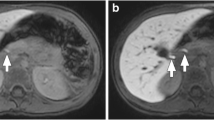Abstract
Magnetic resonance imaging is commonly used to evaluate for hepatic and biliary pathology in the pediatric population. Recently, there has been increased use of hepatocyte-specific contrast agents (HSCAs), such as Gadoxetate disodium in children. Traditionally, HSCAs have been used to characterize focal liver lesions. However, these agents can also be used to problem solve specific hepatic or biliary diagnostic dilemmas. The purpose of this manuscript is to review the practical uses of HSCA in children with both hepatic and biliary indications, and review the corresponding imaging findings. We will highlight the diagnostic uses of HSCA in children, as well as pitfalls encountered.














Similar content being viewed by others
References
Kolbe AB, Podberesky DJ, Zhang B, Towbin AJ (2015) The impact of hepatocyte phase imaging from infancy to young adulthood in patients with a known or suspected liver lesion. Pediatr Radiol 45(3):354–365. doi:10.1007/s00247-014-3160-4
Meyers AB, Towbin AJ, Serai S, Geller JI, Podberesky DJ (2011) Characterization of pediatric liver lesions with gadoxetate disodium. Pediatr Radiol 41(9):1183–1197. doi:10.1007/s00247-011-2148-6
Smith EA, Salisbury S, Martin R, Towbin AJ (2012) Incidence and etiology of new liver lesions in pediatric patients previously treated for malignancy. Am J Roentgenol 199(1):186–191. doi:10.2214/AJR.11.7690
Tamrazi A, Vasanawala SS (2011) Functional hepatobiliary MR imaging in children. Pediatr Radiol 41(10):1250–1258. doi:10.1007/s00247-011-2086-3
Ringe KI, Husarik DB, Gupta RT, Boll DT, Merkle EM (2011) Hepatobiliary transit times of gadoxetate disodium (Primovist(R)) for protocol optimization of comprehensive MR imaging of the biliary system—What is normal? Eur J Radiol 79(2):201–205. doi:10.1016/j.ejrad.2010.03.008
HE O (2015) Pediatric supplemental new drug application—Gadoxetate disodium. http://www.fda.gov/downloads/Drugs/DevelopmentApprovalProcess/DevelopmentResources/UCM446880.pdf
Prescribing information for Gadoxetate disodium (2015). http://labeling.bayerhealthcare.com/html/products/pi/Eovist_PI.pdf. Accessed 7 Sept 2016
ACR manual on contrast media. Version 10.2 (2016). American College of Radiology. www.acr.org. Accessed 7 Sept 2016
Chung EM, Cube R, Lewis RB, Conran RM (2010) From the archives of the AFIP: pediatric liver masses: radiologic–pathologic correlation part 1. Benign tumors. Radiogr Rev Publ Radiol Soc N Am Inc 30(3):801–826. doi:10.1148/rg.303095173
Joyner BL Jr, Levin TL, Goyal RK, Newman B (2005) Focal nodular hyperplasia of the liver: a sequela of tumor therapy. Pediatr Radiol 35(12):1234–1239. doi:10.1007/s00247-005-1558-8
Moore M, Anupindi SA, Mattei P, Sengupta A, Darge K (2009) Mesenchymal cystic hamartoma of the liver: MR imaging with pathologic correlation. J Radiol Case Rep 3(7):22–26. doi:10.3941/jrcr.v3i7.243
Mulliken JB, Glowacki J (1982) Hemangiomas and vascular malformations in infants and children: a classification based on endothelial characteristics. Plast Reconstr Surg 69(3):412–422
Ringe KI, Husarik DB, Sirlin CB, Merkle EM (2010) Gadoxetate disodium-enhanced MRI of the liver: part 1, protocol optimization and lesion appearance in the noncirrhotic liver. Am J Roentgenol 195(1):13–28. doi:10.2214/AJR.10.4392
Chung EM, Lattin GE Jr, Cube R, et al. (2011) From the archives of the AFIP: pediatric liver masses: radiologic–pathologic correlation. Part 2. Malignant tumors. Radiogr Rev Publ Radiol Soc N Am Inc 31(2):483–507. doi:10.1148/rg.312105201
Meyers AB, Towbin AJ, Geller JI, Podberesky DJ (2012) Hepatoblastoma imaging with gadoxetate disodium-enhanced MRI—typical, atypical, pre- and post-treatment evaluation. Pediatr Radiol 42(7):859–866. doi:10.1007/s00247-012-2366-6
Roebuck DJ, Aronson D, Clapuyt P, et al. (2007) 2005 PRETEXT: a revised staging system for primary malignant liver tumours of childhood developed by the SIOPEL Group. Pediatr Radiol 37(2):123–132; quiz 249–150. doi:10.1007/s00247-006-0361-5
Cruite I, Schroeder M, Merkle EM, Sirlin CB (2010) Gadoxetate disodium-enhanced MRI of the liver: part 2, protocol optimization and lesion appearance in the cirrhotic liver. Am J Roentgenol 195(1):29–41. doi:10.2214/AJR.10.4538
Choi JW, Lee JM, Kim SJ, et al. (2013) Hepatocellular carcinoma: imaging patterns on gadoxetic acid-enhanced MR images and their value as an imaging biomarker. Radiology 267(3):776–786. doi:10.1148/radiol.13120775
Author information
Authors and Affiliations
Corresponding author
Ethics declarations
Conflict of interest
The authors declare that they have no conflict of interest.
Research involving human participants and/or animals
This is a retrospective study involving human participants. This article does not contain any studies with animals performed by any of the authors. For this type of study, formal consent is not required.
Informed consent
For this type of study, formal consent is not required.
Rights and permissions
About this article
Cite this article
Ayyala, R.S., Anupindi, S.A. & Callahan, M.J. Practical use and pitfalls of hepatocyte-specific contrast agents (HSCAs) for pediatric hepatic and biliary magnetic resonance imaging. Abdom Radiol 42, 502–520 (2017). https://doi.org/10.1007/s00261-016-0916-3
Published:
Issue Date:
DOI: https://doi.org/10.1007/s00261-016-0916-3




